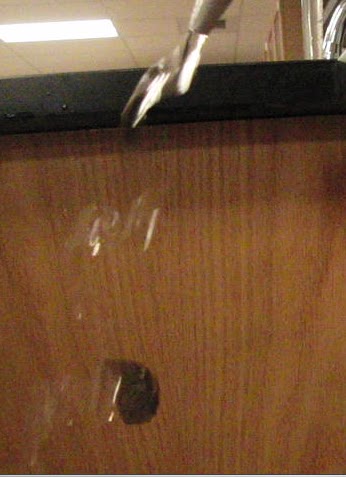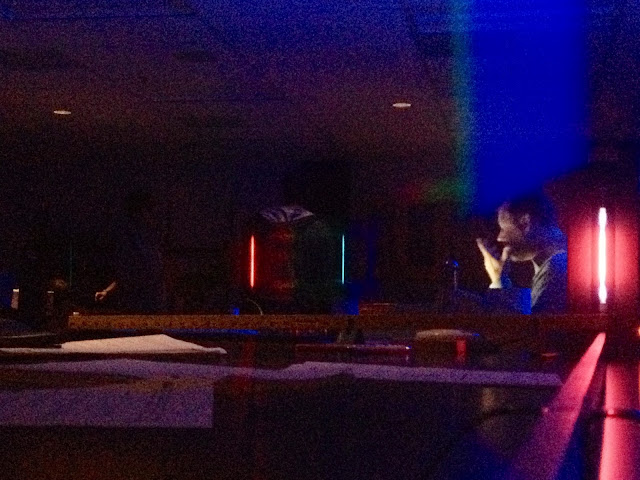Equipment:
- 8 meters of acrylic tubing
- Water facet(2)
- Frequency generator(2)
- Speakers(2)
- Alligator clips(2)
- Large empty bucket
- Paper towels
- High speed camera
- Duck tape
- loggerPro software
The first part of our experiment included a general set up of how we would transfer the frequency from a generator to a stream of flowing water. Michelle Tostado (my project partner) and I agreed that we would get the most repeatable data for future 4C students using two of the Physics4C frequency generator to produce both our waves.
The general set up of our project was drawn and outlined bellow

The first step was to find the correct thickness for our tubing. We had initially attempted our experiment using a garden hose, and that resulted in no appreciable data due to the rigidity of the rubber and surrounding mesh. Therefore, we found that using simple thin aquarium tubing from WalMart Superstore was best, as illustrated bellow.

Our next step was to find a way to properly secure the acrylic tubing, with the flowing facet water, to a speaker. In the case of one single generated sinusoidal wave being produced, it used a single speaker, that had the tubing taped onto it, as displayed bellow.

Some of the issues we had with the first set up was using too much tape, or using too little. The issue was overcome by trial and error, and an observation for expected steady stream of water.

Once we had achieved a correct water pressure to laminar flow of water, we knew our assumptions for fluid dynamics could be simplified and disregard turbulence or rotational velocity in our initial conditions. Therefore, based on Bernoulli's Equation
Our initial fluid velocity was related to the area of the open ended acrylic tubing. Moreover, this allowed for a direct relationship of the water pressure from the facet, eithre increasing or decreasing with the turning of its key, to the velocity of the flowing water bellow.
The first attempt at making a sinosoidal wave utilized the frequency generator at 24Hz with 10 Volts as shown bellow.

The water did not do anything appreciable to the naked eye, and the video bellow is a representation of how it was perceived in person using the human eye as a tool of visual analysis.
The real trick to this problem was using the correct frames per second in the recording instrumentation for this lab. Once the stream of water was recorded at 240 frames/sec, the following behavior was reveled as shown bellow.
It is important to note that the reason the video has a perceived motion is due to the effect known as aliasing. Aliasing is the static distortion in digital video caused by a low sampling rate. This phenomenon must be familiar to you if you have ever brought a camera near a computer monitor and observed jagged patterns.
The manner aliasing is manefested in our experiement is as follows. In the harmonic frequency, the frames per second and the frequency generator are in synch. The result is an apperance of stilness at the 30Hz frequency.
At a lower frequency of 28Hz, the water appears to be moving up. The manifestion of aliasing in this video is at a slower rate, so the frequency is simply falling behind.
An example of a leading frames per second occurs at 32Hz, giving the water flow an apperance of a downward motion.
In figuring out how to computationally analyze the videos and still frame-shots of this experiment using loggerPro, we found another significant fluid dynamics variable. The water poured down of the open end of the acrylic tubing with a velocity vector pointing downward, but it also had another velocity vector pointing at an angle, producing a parabolic projection downward as illustrated bellow due to gravitational force.
 |
| Velocity Vectors of water faling (2D Aspect) |
With this of rotational parabolic motion in mind, we knew we would have to configure our data two dimensionally to be able to analyze our project.
In addition to the analysis of a single wave phenomenon, our objective was also to analyze the interaction of TWO water waves in a constructive and destructive intereference pattern.
The constructive wave pattern set two hoses in two different facets(as shown bellow), each attached to an individual speaker, running from the same frequency generator to reduce differences in frequency.

The two acrylic tubing were held in the same plan parallel to one another by one of the students to insure an ideal trajectory and point of contact. Bellow is an illustration of the two speakers side to side ready to be tested.

In addition to coupled data collection, we also dealt with a cleaning problem. The experiment created a large wet mess, that was largely contained by two buckets, but some spill over still managed to sufficiently dampen the tile floor.
 |
| Wet and messy floor |
Our cleaning procedure was then set to use paper towels, to avoid having a lab safety hazard and a possibility of slipping on the surface, as soon as we had collected a visual recording of the experiment.
 |
| Lab safety and cleaning protocal |
Data Analysis:
Our data analysis involved using the software loggerPro. Both video and still shots of the experiment were utilized to analyze the sinosoidal behaviour of our fluid waves.
Bellow is the still shot of the frequency of 28Hz
The methology used was plotting various data points, following the stream of water, manually into the uploaded picture. The multitude of red dots were then put against an axis and fit against a sine wave.
A linear regression line was also used to find an arbitary value of the planer speed of the stream of water, which resulted in a value of 3.328 +/- 0.001
Following, the 30Hz fundamental frequency was also analyzed using logger pro from the following still shot.
Lastly, the 32Hz frequency generated a stillshot to be analyzed using logger pro
Without surprise, the computational analysis of this wave resulted in a fitted sinosoidal wave, just with a smaller RMSE of 3.736
Conclusion:
Based on the sinosoidal function fitting of the fluid stream of water, we have determined that they are in fact sinosoidal waves. This analysis was been possible due to the simplification of the parameters, assuming laminar flow and ignoring the various angled velocity vectors that parabolically extend the wave as it falls, ignorning gravitational acceleration at the bottom tier of the wave, and selecting the characteristic first few waves for analysis.
In addition, we also figured out that our parameters were well define to analyze a 2 dimensional wave from its profile. Yet, the constructive and destructive waves interacted in all planes and provided puzzling data, which at this time, we are unable to grasp and analyze since it would require various perspective simulatenous analysis from at least three video sources to compare and contrast each perceived interaction with one another.
As a whole, the objectives for this project were met. We were able to 1) analyze aliasing 2) developing sinosoidal wave using the frequency generator and 3) utilize computational modeling of sinosoidal waves from data for an uncertainty value.






























